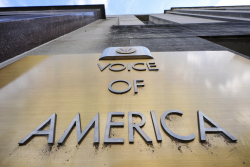While the agreement is short on details, President Trump should continue to work toward a clearer resolution of the Red Sea crisis.
The United States has inked a vague agreement with the Yemen-based Houthi Movement (Ansar Allah) to end their fighting in the Red Sea. The shocking announcement immediately raised many questions, not limited to whether the deal includes all Red Sea shipping and Israel—the latter of which the Houthis continue to strike. Yet, even with limited details and conflicting reports about the substance of the agreement, the decision to end fighting with the group marks a crucial moment for U.S. foreign policy in the Middle East.
The deal comes after reports hinted at a renewed ground war in Yemen, backed by U.S. material support for the Internationally Recognized Government (IRG) of Yemen. According to The Wall Street Journal, the United Arab Emirates approached Trump administration officials with a plan, hoping to take advantage of the U.S. air campaign by conducting a parallel ground operation into Houthi territory. From their perspective, the U.S. air campaign could open the door for pro-government groups against weakened Houthi forces.
That thinking is flawed because it discounts similar failed approaches and the risks of renewed fighting. Consequently, the Trump administration was wise to cut a deal with Sanaa, especially after the failure of the renewed U.S. operation against the Houthis that began in mid-March. While the U.S. Central Command (CENTCOM) claims over 1,000 strikes on supposed Houthi positions, it refused to share many details about the strikes, including casualty numbers and type, weapons used, and enemy assets destroyed. The Trump administration—known for its boisterous efforts to highlight policy victories—claims success but refuses to share much evidence, hardly promoting confidence in such statements.
Most information on the U.S. strikes comes from civil society and the United Nations, which continue to track civilian casualties under Operation Rough Rider. Thus far, conservative estimates suggest 158 civilians killed and 342 injured between March 15 and April 22—not including an April 28 strike on a Houthi migrant detention center that reportedly killed upwards of sixty-eight African migrants. According to the Yemen Data Project, the total accounts for a civilian harm rate of 2.12 civilians per strike, marking a tremendous increase in civilian harm from the previous U.S.-led air campaigns in Yemen.
That tracking comes as U.S. Congressional sources and allied military officials claim Department of Defense officials briefed them on the operation’s limited success. Rather than the “decimation” senior Trump officials claim in public, the Houthis have again hardened critical sites and dispersed resources and personnel, just as they did during the Saudi-led bombing campaign between 2015–2022. Meanwhile, the operation’s cost is in the billions of dollars, including $750 million in munitions needed for other military theaters amid lacking domestic production capacity. Meanwhile, the Houthis have shot down at least seven MQ-9 Reaper drones—worth $30 million apiece.
The risk to U.S. troops remains high as well. On April 28, one of the two US aircraft carriers in the region—the USS Harry S. Truman—barely evaded Houthi fire. In that incident, an F-18 worth roughly $60 million fell overboard, nearly taking crew members with it. Another F-18 was lost in an unclear incident on or around May 6. High-ranking military officials describe the fighting as the most intense for the U.S. Navy since World War II.
One should question the operation’s viability given the costs and risks, let alone the substantial levels of civilian harm due to Trump’s softening of civilian protection mechanisms. That says nothing of Washington potentially supporting a renewed proxy conflict—still a real possibility given the lack of clarity around the U.S.-Houthi agreement. Given Trump’s erratic approach to foreign policy, it is crucial to view renewed fighting that includes support for ground operations in Yemen as an expansion of the conflict, reminiscent of the mission creep plaguing U.S. military adventures in the post-9/11 era.
Indeed, if Washington hopes to end Houthi strikes on international shipping, why did it consider expanded efforts to renew the conflict in Yemen with actors who seek to fully eliminate the Houthis? Is this approach still being considered if the agreement collapses? Equally important, why is Washington cutting bilateral deals with a group that appears not to include all international shipping if that was the original goal?
Such questions highlight the conflicted nature of the U.S. approach. Trump’s second term has been marked by intense conflict between restraint-oriented staffers who prefer cutting deals with U.S. adversaries and neoconservative staffers who prefer a more confrontational approach.
Yet, the neoconservative position is more of the same failed thinking from the past. In this context, some may argue that local forces will play the role of further pressuring the Houthis. These arguments are disingenuous, namely because U.S. officials have repeatedly shown an inability to avoid expanding their involvement in such conflicts.
Evidence abounds in this regard, from Iraq and Afghanistan to Syria and the Horn of Africa. Are U.S. citizens—who supposedly gave the Trump administration a mandate to reduce foreign spending and foreign wars—expected to profess collective amnesia about those past conflicts and last year’s election promises?
U.S. policy must answer a simple question: “How does this end?” Any reading of the conflict and increased US involvement suggests a long and ugly slog of fighting, producing tens or hundreds of thousands of deaths. With U.S. and Emirati backing, IRG-aligned forces would meet a formidable and massive Houthi military along a frontline with multiple major cities. The Houthis would likely renew missile strikes on IRG cities and infrastructure alongside major Gulf cities—particularly the UAE. Simply put, it will not be easy to close the lid once these steps are taken.
A conservative estimate suggests the outcome of that scenario reflects the past: a brutal conflict along relatively frozen lines. That assessment assumes the anti-Houthi bloc suddenly finds the ability to cooperate—something it has been unable to do since the war started in 2015, given its many competing factions. Wishful thinking that rejects the true nature of a conflict for how policymakers might wish it would be is the basis for mission creep.
Worse, in a scenario where fighting resumes in both the sky and on the ground, famine conditions are guaranteed to return to Yemen. Remember, the country experienced one of the century’s worst humanitarian crises just a few years ago, with images of starving babies leading former U.S. President Joe Biden to remove the Houthis’ Foreign Terrorist Organization (FTO) designation to improve the humanitarian situation. Trump’s decision to re-instate that designation—alongside his administration’s decision to cut most foreign humanitarian aid operations—highlights the human risks of any renewed, widespread fighting on the ground.
Rather than continuing to dig deeper into the conflict in Yemen at the expense of Yemeni lives and a sound regional strategy, Trump would be wise to listen to the restraint wing of the White House, opting for a solution to the issue that has existed since 2023. The Houthis continue to connect their Red Sea attacks to a ceasefire in Gaza and have acted on the promise that those attacks will end when the war on the Strip ends.
Whether Washington’s new deal with the Houthis signals better days remains to be seen, but it could be a step towards broader peace if the right moves are made to achieve it. Regardless, if Trump is truly a president of peace and a dealmaker, he will recognize that one deal can finally quiet the Middle East should he have the political bravery to pursue it.
About the Author: Alexander Langlois
Alexander Langlois is a foreign policy analyst and Contributing Fellow at Defense Priorities. He is focused on the geopolitics of the Levant and the broader dynamics of West Asia. Follow him on X: @langloisajl.
Image: Spyros Vasileiou / Shutterstock.com.
















